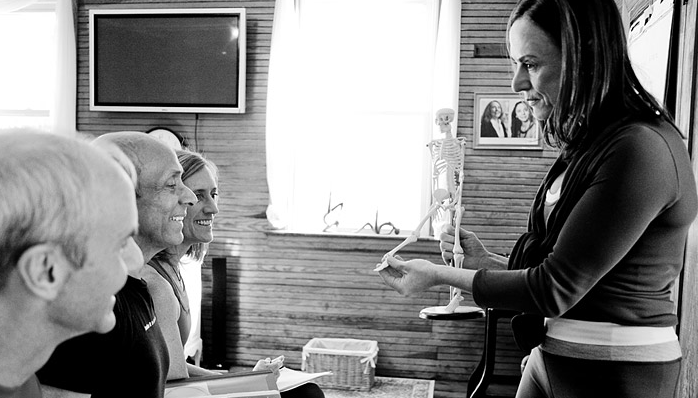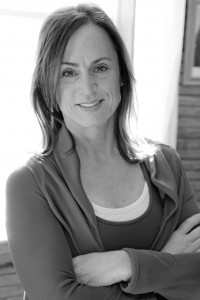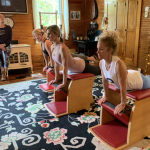March 12, 2020
Engage Deeper into your Teaching
by Clare Dunphy-Hemani
I think most Pilates teachers today share the belief that our lineage has value because the connection back to Joe, either directly or through one of his students (our elders), helps keep the tradition alive. It wasn’t that long ago when that link meant we all had a fairly strong percentage of shared knowledge that came from Joe. After all, he was the creator of the method, and if we describe what we do as “Pilates”, then we should honor his work.
For me as a budding new teacher-in-training, what impacted me most was having the opportunity to see a master teacher at work. Romana let us see her up close and encouraged questions. What a gift to witness her genius in action; she frequently shared “Uncle Joe” stories and quoted him often. My early experience with Romana, plus the teachers who were around the studio, made a deep impression as we practiced and discussed day by day. We kept learning and learning and learning – it was a rich community.
Later on, I sent my students to Romana for a lesson whenever they visited NYC so she could see, through their work, if I was teaching them proper transitions, right rhythms, and orders. My students were MY report card and I understood that I was accountable for making sure they knew their work up to their capability. As a result, I felt personal responsibility to uphold my own standards in both my teaching and practice.
But now, without that kind of accountability, where do teachers turn? I’ve been noticing a growing set of teachers who missed out on that experience and are looking to fill in some gaps from their initial education. Now I’m in the position to help mentor and guide other teachers. Teachers with varied experience come to me for advice and support. They each have a big heart and a true ambition to be a high-quality teacher – which I admire. In my quest to be a second-generation leader in the community, I’d like to share my approach to mentoring. Here’s a sample of how our interaction might sound.

Let’s say you’re attending my Advanced Teachers Seminar. I recognize you’d likely benefit from my insight to better understand how to flesh out a lesson strategy that progresses your client specifically towards a particular goal. I ask you questions to see what you think is going on in a scenario. I say something like this: “You might notice a lot of things going on, but what stands out as a priority? What are the exercises where you will probably see this issue show up again, and why does it matter for your client’s progress? How might you adjust the exercise to see improvement and which other apparatus can you narrow in on to address that particular issue?”
Then we explore together:
- What do you notice in the first 4 exercises on the Mat?
- What do you notice in the first 4 exercises on the reformer?
- What do you notice that can help you zero in on a particular issue?
We build on the discussion with the next layer of questions until we zero in on the issue we will tackle. Let’s use this as an example:
You might see something “off” during footwork and you’re not quite sure what. For example, we see them not stretching their legs or perhaps jamming out locked knees. Maybe they aren’t using their entire leg but just the quads.
We start at the powerhouse to make sure they are organizing the “in and up” with their abs, the inner thighs into the midline seat is active. They have square pelvis and shoulders and equal lift in the right and left side of their waist. By starting here, many things improve without getting too picky in the first exercise. We give simple cues they can implement while they are moving.
Then (while they are moving) we check out ribcage placement, tension in the shoulders or neck. And the knees, ankles, and feet.
Our discussion leads to where this might show up again, so you can help your client understand and gain awareness and bring the lesson learned to that exercise. Maybe the arches drop in footwork and we know we’ll see it again in the stomach massage series or running, for example.
Finally, we brainstorm where else in the System we take them or maybe a variation that’s more suitable to focus on this issue. After coming up with a list (in this case, maybe the Achilles Stretch on the high chair, 2×4 exercise, Foot Corrector, etc.), sometimes we must look deeper at another root to the problem. Other times we try an exercise, correction, or touch that leads us to another clue.
The dialogue between us helps me understand what you are seeing, how to help plan a strategy, and in turn informs me what to suggest to help you approach your cueing and teaching so it all works together better. It’s a collaboration between us.

I like asking questions about what you notice about a person in those first few exercises because it opens the discussion about what you see and what you don’t see. And it challenges you to look at the big picture as it relates to the details and then adjust your teaching approach in order to see a difference – in that moment. It also helps expand your critical thinking skills to include the what, why, and how.
This is one of many areas that I have helped teachers to develop, and I love doing just that! This is why I have created The Advanced Teachers Seminar, a 60-hour master’s program for comprehensive teachers with 5+ years of teaching experience. The program takes place over three 3-day weekends during the year. If you can’t make one weekend, you can make it up the following year. We cover all apparatus thoroughly. There’s no assessment at the end; we simply dive into the work and you get judgement-free feedback, an action plan, and a community of like-minded teachers to grow with. I hope to meet you there!
To learn more about Clare’s background and philosophy, listen to her Pilates Unfiltered interview and scroll to the 25 minute mark.
For the time being this article is only available to subscribers.
Click Here to Subscribe and Receive Full Article
****If you are subscribed, and would like a copy of this article, please mail to admin@pilatesintel.com specifyng the articles that you would like and they will be sent to you.
 Clare Dunphy Hemani My roots in the field of human movement began at Northeastern University in 1980 where I studied Exercise Science, continuing my education with certifications from PMA, ACE, and Romana Kryzanowska. I began my Pilates studies under Romana Kryzanowska in 1995 and continue my studies with master teachers to this day. I present on Pilatesology.com and PilatesAnytime.com, and host two free video channels on Vimeo.com for students and teachers. From 2001-2013 as co-author of the Peak Pilates Comprehensive Education Program, I mentored scores of teachers and teacher trainers, which opened my eyes to the value and need to coach the next generation of teachers. I’m committed to preserving the authenticity and tradition of The Pilates Method of Body Conditioning, and to creating learning environments that are refreshing, energetic and supportive. I’m the founder of Pilates Avatar®, a comprehensive audio program designed for practitioners of all levels to help them gain greater ownership of their practice. I also teach The Advanced Teacher’s Seminar, an annual Master’s Program. My gift is my willingness to share knowledge generously and explain concepts with clarity. My mission is simple: Get more people doing Pilates!
Clare Dunphy Hemani My roots in the field of human movement began at Northeastern University in 1980 where I studied Exercise Science, continuing my education with certifications from PMA, ACE, and Romana Kryzanowska. I began my Pilates studies under Romana Kryzanowska in 1995 and continue my studies with master teachers to this day. I present on Pilatesology.com and PilatesAnytime.com, and host two free video channels on Vimeo.com for students and teachers. From 2001-2013 as co-author of the Peak Pilates Comprehensive Education Program, I mentored scores of teachers and teacher trainers, which opened my eyes to the value and need to coach the next generation of teachers. I’m committed to preserving the authenticity and tradition of The Pilates Method of Body Conditioning, and to creating learning environments that are refreshing, energetic and supportive. I’m the founder of Pilates Avatar®, a comprehensive audio program designed for practitioners of all levels to help them gain greater ownership of their practice. I also teach The Advanced Teacher’s Seminar, an annual Master’s Program. My gift is my willingness to share knowledge generously and explain concepts with clarity. My mission is simple: Get more people doing Pilates!
Follow Clare at www.progressivebodyworksinc.com and on Facebook and Instagram.

